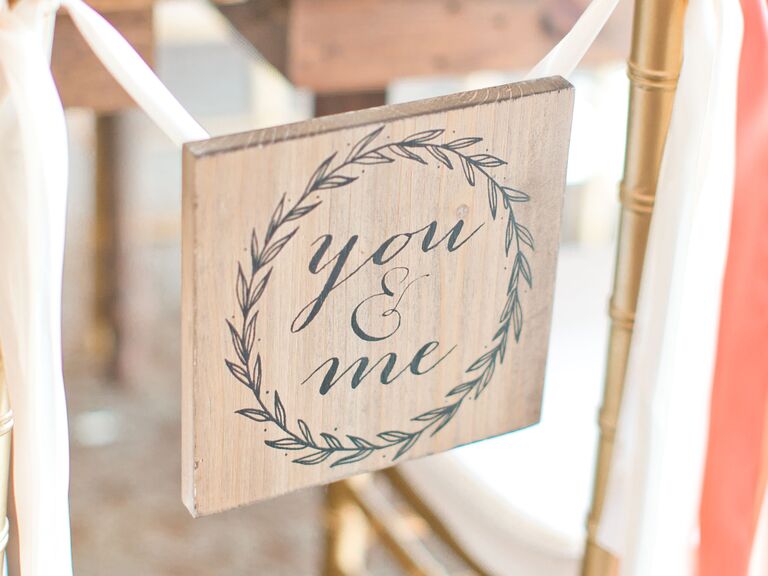Considering a Hyphenated Last Name? Here's What You Need to Know
There are plenty of reasons why you might be hesitant to take your partner's name after marriage—and you certainly aren't alone. Some people have established a successful career with name recognition. Others simply prefer their original surname or have strong ties to their lineage. But what if you still want to honor your union and your new family's roots? How do you decide which moniker to take if you're torn between the two? In all these cases and many more, the perfect solution may be a hyphenated last name, aka using two last names postwedding instead of just one.
In this article:
- What is a hyphenated last name?
- Are hyphenated names legal?
- What are the pros and cons of hyphenated names?
- How do you hyphenate your last name?
- What are examples of hyphenated last names?
What is a hyphenated last name?
A hyphenated last name is just what it sounds like: your and your partner's last names, connected with—you guessed it—a hyphen. Oftentimes, hyphenated last names are described as a merge of a woman's "maiden" and "married" names (her prewedding surname and her spouse's surname). But this name change option definitely isn't gender-exclusive. Either (or both!) partners in any union can adopt a hyphenated last name.

Are hyphenated names legal?
Or, more specifically, if you hyphenate two last names, which one is your legal name postwedding? The answers are yes and both, so long as you've undergone the legal name change process using the hyphenated surname—more on that below.
Just keep in mind that once you opt to hyphenate, you have to stick with it, as all formal documents and situations requiring exact identity (such as airport customs, job applications, tax filings, etc.) will call for both names and the hyphen. You can't hyphenate and then flip-flop between your original name and your partner's name when it comes to official paperwork. You can't drop the hyphen or switch the order of the two last names either. All that said, some people do use just one or the other in casual settings, like when they're making restaurant reservations. (That way, they avoid having to spell out both hyphenated names over the phone.)
What are the pros and cons of hyphenated names?
The biggest advantage of hyphenated last names is the absence of having to choose between two last names. It allows you to retain your identity while still legally adopting your partner's moniker.
However, there are some drawbacks to hyphenating. If you become a parent and one partner has a hyphenated last name while the other doesn't, you may have a different last name than your children. Believe it or not, there could also be technical difficulties. Some online forms may not correctly read or register your name (think: counting the hyphen as an invalid "special character"). And according to Jake Wolff, the founder of popular name change service HitchSwitch, character limits come into play too. "Remember that certain IDs (your passport, driver's license, Social Security card, etc.) are only so big," he warns. If your two last names are really long combined, they may not fit and you could actually have to choose a different surname option! ( Even if they do fit on your IDs, you may run into future roadblocks writing them out in full.
How do you hyphenate your last name?
Once the wedding is over and you're ready to adopt a hyphenated last name, you'll need your marriage certificate to initiate the change. The document lets you legally take your partner's surname or a combination of your two last names after marriage. In some states, the marriage license application asks soonlyweds to declare their married name before the wedding day. Pay close attention, because if yours does and you don't, you'll have to petition the court for a name change instead (which is a much more involved—and usually costly—process). In other states, the application asks for just your original names. In that case, you have until after the wedding to decide on a course of action.
Check out The Knot's step-by-step guide to changing your last name. (Psst… we also have how-to guides by state.) There's also the option of a name change service like HitchSwitch, which really cuts down on the research and paperwork you have to do. The team has seriously impressive expertise in all sorts of name change situations, so you can go to them with any specific questions you may have about how to hyphenate your last name. The company offers three different packages at pretty reasonable prices, so you can be as involved (or blissfully uninvolved!) in the process as you want.

What are examples of hyphenated last names?
When it comes to hyphenated last names, which goes first? Generally, there are no set rules or etiquette when it comes to deciding exactly how your hyphenated last name will read. You can go the "traditional" route and list your "maiden" name first, or you could choose to list your new last name first, followed by your original last name. Some couples decide to have both partners change to the hyphenated last name, as a show of unity and equality. But can you have two last names while your partner only has one? Absolutely. Let's look at an example:
Suppose Alex Atkinson marries Taylor Lloyd. They could change their name(s) in the following ways:
- Alex Atkinson-Lloyd
- Alex Lloyd-Atkinson
- Taylor Atkinson-Lloyd
- Taylor Lloyd-Atkinson
At the end of the day, changing your name is a personal choice—whether you're hyphenating it, taking your partner's last name, or deciding not to swap surnames at all. Talk it out with your S.O. to determine what's right for you both.
Looking for other name change options? Read about more ways to combine your names after marriage.
Christin Perry contributed to the reporting of this article.





















